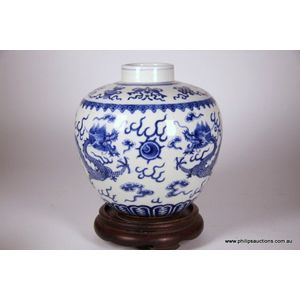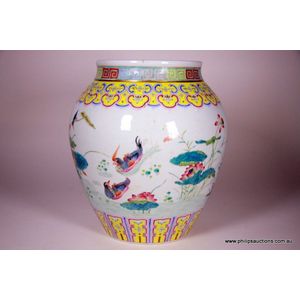Famille Rose Lotus Garden Pot
You must be a subscriber, and be logged in to view price and dealer details.
Subscribe Now to view actual auction price for this item
When you subscribe, you have the option of setting the currency in which to display prices to $Au, $US, $NZ or Stg.
- Qing Dynasty - The Qing Dynasty was the last imperial dynasty of China, ruling from 1644 to 1912. It was established by the Manchu people, who originated from the northeastern region of China. The Qing Dynasty was preceded by the Ming Dynasty and followed by the Republic of China.
- Lappet Decoration - In the context of furniture, ceramics, and oriental wares, the word "lappet" refers to a decorative motif that consists of a repeated pattern of stylized or abstracted "lappets."
A lappet in this context is a decorative element that resembles a small, hanging flap of cloth or fabric, but rather are stylized patterns that resemble the shapes and folds of lappets. They can be found on a wide range of objects, including furniture, vases, bowls, and plates.
Lappet decoration can take many different forms, but typically consists of a series of semi-circular or pointed shapes that are repeated in a continuous pattern. The shapes may be simple or highly ornate and may be arranged in a regular or irregular pattern. The design may also include other decorative elements, such as floral or foliate motifs.
Lappet decoration is often associated with Asian design traditions, and can be found on a wide range of objects from these regions, including Chinese porcelain, where lappet decoration is often used as a symbol of abundance and prosperity, and is believed to have protective and auspicious qualities. - Oviform /ovoid - The outline loosely resembling the shape of an egg.
This item has been included into following indexes:
Visually similar items

A Chinese porcelain polychrome decorated jardiniere, people's Republic of China era, second half 20th century, the cylindrical jardiniere with a waisted neck and foot, with zoomorphic and ring lug handles, decorated with a continuous narrative scene of nin

Figural Chinese vase Qianlong mark in the baluster shape and painted with Chinese nobles in a mountainous scape.Stamped to base. Condition: good, some fading to paint other small wear height 33 cm

A Chinese famille-rose twin-handled vase, Jiaqing six-character iron-red seal mark 28.5 cm high

A good Chinese blue and white jar, probably early people's Republic period, mid 20th century, the ovoid tapering jar with a shallow neck, decorated to the collar with Buddhist symbols between guilloche and ruyi borders, and to the body, dragons chasing a p
